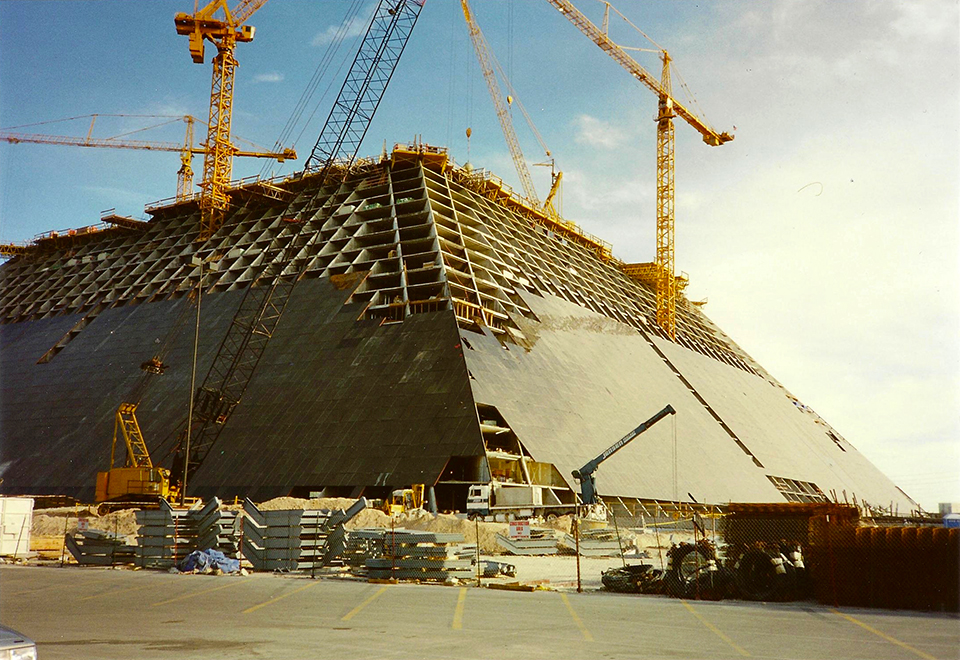
Luxor’s Questionable Origins: the Crookedness of an Era Gone-by
Editor’s Note: The source of this article wishes not to be revealed yet. —This is an amazing look behind the crookedness of an era gone by in Vegas history. To see the underbelly, back-stabbing operations of folks who took full advantage of the kindness of others by doing a ‘reinterpretation’ of other’s ideas and pitching them as their own. We at VegasBright will leave the decision up to you, our readers, to determine your own take on this.
This is a synopsis of the similarities regarding Mr. L’s Luxor project destined for Sinai, Egypt (1986) and two other subsequent interpretations of his ‘original’ modernistic version of an ancient Egyptian-styled resort. It all began following Mr. L’s presentation of a rendering depicting his Luxor international destination resort (as well as a peace pavilion designed by Morris Lapidus, renowned architect of Miami’s Fontainebleau Hotel) to a public relations firm in Washington D.C in 1987. The entire project had been presented to a certain party in Cairo, Egypt (1986) that was to be done in dedication to the peace initiative known as the Camp David Accords. The project was to be constructed near Mount Sinai and Sharm-el-Sheik, Egypt in the mid-1980’s, which was also to include its own international peace conference center.
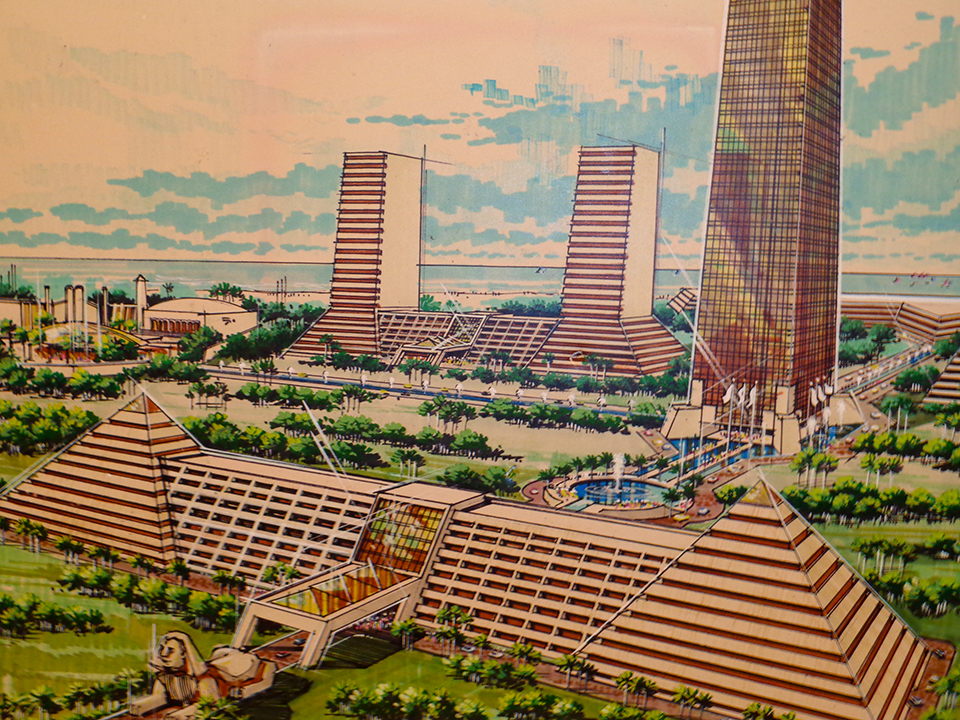
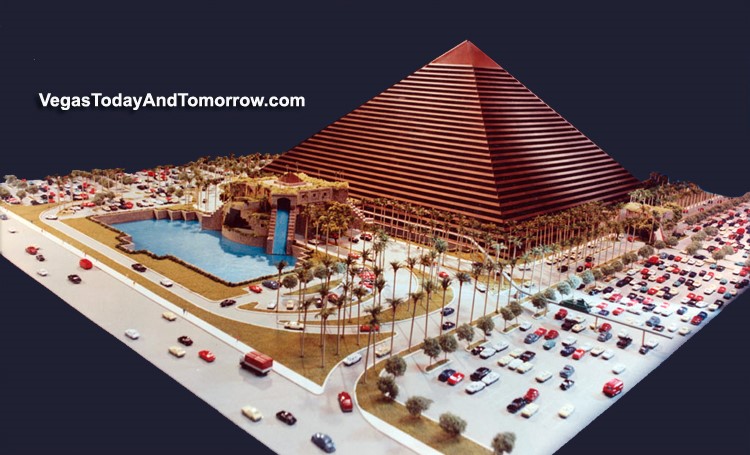
After his investors learned the country of Egypt demanded majority ownership in the proposed resort (even though his investment group maintained a majority financial position) and then being told that his Sinai project might be considered too risky to proceed with at the time, the project never materialized.
Mr. L had received permission to include a vision of one of the world’s great dignitaries (who was also a signing member of this historic peace accord) during a meeting with family members. A revision was later made to an initial rendering of his Luxor project in 1987 following his trips to the Middle East, after collaborating with Morris Lapidus (Fontainebleau Miami Beach architect) who originally designed the peace pavilion. He was then asked to present this revised rendering to the family’s public relations firm in the United States. Following a presentation of his ‘revised’ Luxor rendering to this firm in May of 1987, he was then later told the public relations firm believed the project was a most idealistic one but viewed it as having too many inherent risks to proceed with. Mr. L asked that he simply be contacted if things changed.
Following this most disappointing decision, it was nearly eight months later that he then decided to meet with a former business acquaintance from Torrington, Connecticut, who was considered to be a ‘crucial’ potential investor. After presenting the project to this same Mr. Z at a personal meeting in early 1988, Mr. L was informed that he knew of some business associates that might be interested in investing in a slightly smaller version of the project if it were done in the United States.
Mr. L had given Mr. Z a projector slide version of his Luxor project to present to his group of potential investors and others who might be able to assist with the project’s funding in the United States. He had also told Mr. Z that whenever he found a group capable of financing or assisting with the project in any way, to simply contact him to set up a meeting at their earliest convenience to discuss the project.
Mr. L never heard back from either Mr. Z (or the other public relations firm he’d presented his project to in May of 1987) thus forcing his project to be put on hold. Mr. L’s Luxor project had been shared with these two separate parties in strict confidence and although his lawyers recommended that the parties he had shown the project to sign a non-disclosure agreement, he felt he trusted these same two well-respected parties, due to their status in the business world. The first being a public relations firm representing a party who would have an interest in seeing the peace pavilion built in honor of a loved one, the second, being a trusted former business contact he had met years earlier while living in Florida.
It was only later that details were uncovered after the previous interactions that took place with the two separate parties during the promotion of his project. Names will not be revealed, but only a few key references given to provide a glimpse into some rather eerily similar projects promoted and highly publicized months or so after his presentations were made to the two different parties.
The similarities between Mr. L’s Sinai Luxor project and those about to be discussed are just that. How it was that these two other ancient Egyptian resort proposals came about is highly suspect (the first was announced just months later in 1988, with the second being resurrected just a year or two later in 1990).
The first of the two projects was Pharaoh’s Kingdom (1988-1989) which was proposed by Mr. Z’s business associate (a major developer from near his hometown of Torrington, Connecticut (a Mr. S). The second project being the more well-known ancient Egyptian resort that later arose at the southern end of Las Vegas Strip just a few years later. We all know how influential that project became during the highly-themed era of the 1990’s.
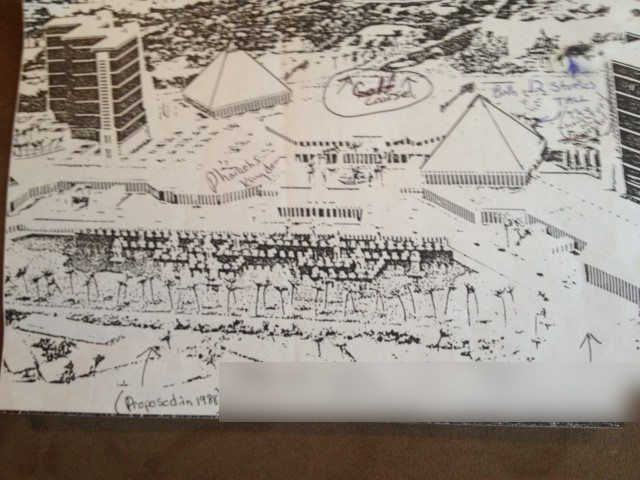
The proposed Pharaoh’s Kingdom resort of 1988 was ‘supposedly’ the brainchild of Mr. S, who just months after having been presented with the slide (depicting the rendered version of Mr. L’s Luxor project) by Mr. Z in the spring of 1988, then headed to Las Vegas with his ‘own’ ancient-Egyptian resort plans. He aligned himself with a Dunes casino marketing executive, as well as a couple of well-known casino development specialists. One was Risman-Risman (designers of the original Circus Circus) likely due to the group’s previous experience with ‘themed’ casino design.
Pharaoh’s Kingdom had been intended to be a large-scale real estate project that was to include a major casino, 12-story Pyramid Hotels, a few 40-story glass hotel towers, a Sphinx, an 18-hole golf course, as well as residential units at a projected cost of 1.6 billion. Some of the project’s questionable financing was to come from numerous sources (including Ferdinand Marcos), who had been exiled from the Philippines around this time, but later died. If you were to google Pharaoh’s Kingdom developer and missing Swiss bank account funds in the late 80’s you will discover some interesting discussions regarding this proposed project intended for Las Vegas.
As expected, the Pharaoh’s Kingdom project’s funding soon collapsed with all of these pyramid–like designs later being sold to one of the most influential leaders in the casino industry around 1990, with similar pyramid-like designs to appear years later in this other casino operator’s future projects.
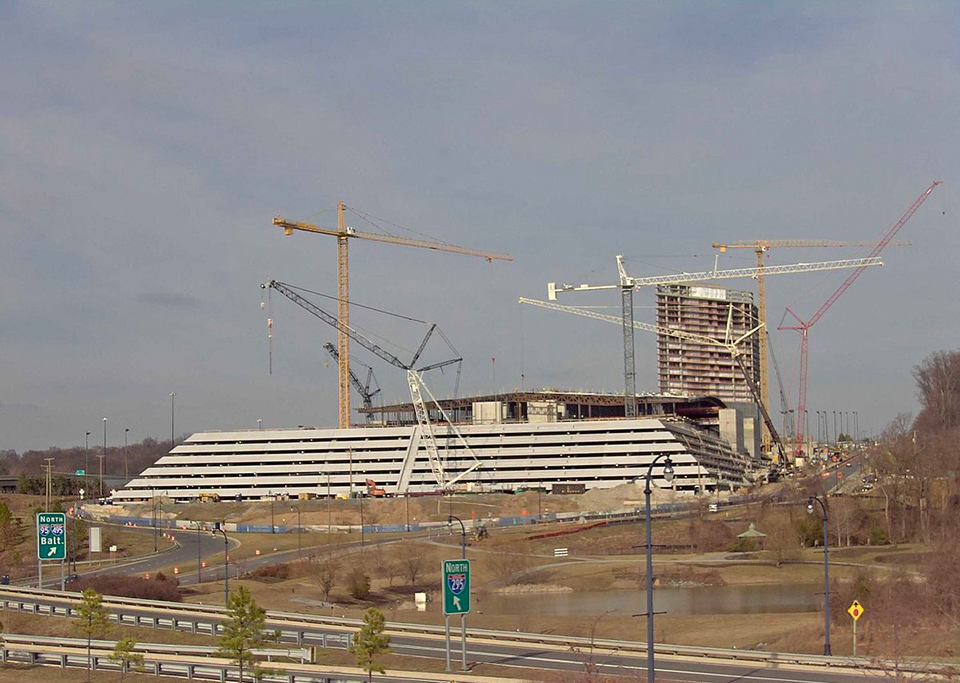
Following the debacle of Mr. S’s Pharaoh’s Kingdom proposal, there was considerable interest in this ancient-Egyptian resort concept. Shortly after learning that this gentleman’s Pipe Dream turned to dust in the desert, key casino operators expressed a keen interest in developing something similar. When another major gaming operator decided to step forward (coming up with ‘their own’ pyramid-themed resort concept) this also became known to the other party that Mr. L had originally given a copy of his Luxor rendering to. This same PR firm then apparently formed a silent relationship with this interested major gaming operator. This relationship seemed to be supported during a phone call Mr. L made to the PR firm’s CEO after returning from a trip to Las Vegas where he had videotaped the Luxor and then later reviewed it with his lawyers. Mr. L decided to pretend to be ‘another’ major developer reaching out Mr. CEO for assistance with potential developments in Saudi Arabia, Jordan and elsewhere in the Middle East, saying he had heard his firm had Middle Eastern contacts. (simply a probing call to the firm’s CEO).
During this brief telephone discussion, Mr. L was told that, “Yes, I have worked with numerous people in the Middle East and as a matter of fact, Mr. G. (a former Ambassador from a ‘certain’ country) is sitting here with me discussing our designs for the King Tut replica display planned for the new Luxor Hotel.” This CEO then went on to say that he also represented another party (the same party who had originally granted permission to Mr. L to use the peace pavilion design in his proposed Luxor project to be located in the Sinai area of Egypt). Mr. L. had to restrain himself, yet thanked him and said he would call back.
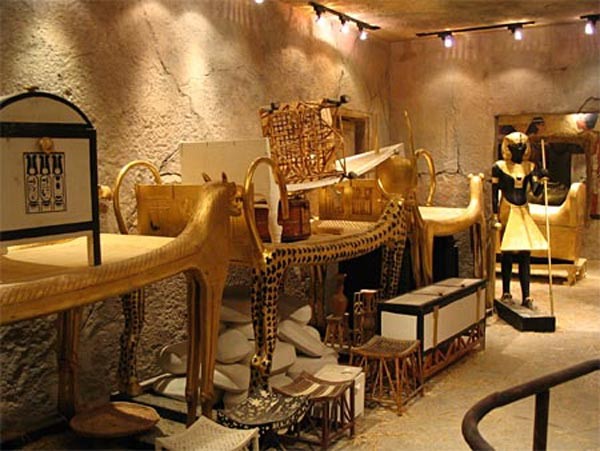
My question is, would it not be reasonable to assume that the very same plans presented to these two different parties between 1986 and 1988 then somehow ended up in eerily similar projects produced just months after both parties received renderings (copies) of Mr. L’s Luxor project? It would seem highly probable. Although it has never been claimed that the proposed Pharaoh’s Kingdom project (nor the Las Vegas Luxor Hotel) were infringements of Mr. L’s Luxor project, it is important to highlight many of the ‘key elements’ contained within all of the Egyptian-themed projects propagated in the late 1980’s.
The original Sinai Luxor proposal of Mr. L’s was to be a modernistic interpretation of an ancient Egyptian Luxor civilization brought to a major desert. The name Luxor came to him at the same time he came up with the Egyptian pyramid hotel designs, following the signing of the Camp David Accord. The name LUXOR also suggested ‘Luxur-y’ (the bronze, brass and gold accents of the Pharaonic Era). Guests were to enter through the paws of a gigantic replica of the Giza Sphinx, parking directly under a large bronze-reflective glass pyramid hotel located behind it. Beyond this pyramid hotel one could also stay in the much larger peace pavilion’s hotel, or one of two twin stepped-pyramid Karnak-styled condo towers. It was also to have an obelisk-shaped bronze-glass International Conference Headquarters. Beyond that lie an eagle wing-like designed ‘tiered’ beach hotel for guests scuba diving in one of the best deep-sea diving areas in the world (designs not unlike an Eastern United States hotel that has a pyramid-like pedestal). It truly was to be one of the most prestigious projects to be built in the world.
Were the other two proposed projects a mere coincidence, or something much more sinister?
[Images: Norbert Aepli, Mark Wagner, Las Vegas Today and Tomorrow | and Mr. L]
One thought on “Luxor’s Questionable Origins: the Crookedness of an Era Gone-by”
Comments are closed.


This was a great read! I love pieces like this. I didn’t realize that the crooked business practices of eras past extended that far into the 80s.